Import Voice Track in Garage Band Audio
Watch this video version of this lesson, or see the same content presented through text and images below.
You can download the raw audio file used in this tutorial, as well as our final, edited version.
What's in this lesson:
- The editing process
- Listening for edits
- Using your cursor
- Selecting, cutting, and moving audio
- Using the undo function
- Adjusting audio levels
- Exporting your edited file
Before you begin
Once you import the raw audio, make sure to save your Garage Band file and give it a name.
Our editing process
At Smarthistory, we dive right in and edit as we listen to our audio the first time through. We usually do at least three rounds of editing (most often it's 4-6).
On round 1, we…
- edit for general content by cutting out fragments of sentences or places where we misspoke
- cut out extraneous words—"um," "uh," or words like "actually" or "in fact"—as well as breaths and pauses
On round 2, we…
- tighten things up more, catching places where we missed small words or breaths on the first round
- create a coherent story by deleting larger sections—we may decide, for instance, that a particular tangent or detail is not worth including
- in rare cases, we may move something around so that it makes more sense
Tip: Because Smarthistory is based on a conversational approach, we try to keep the edited audio as true as we can to the flow of the original conversation. We only move big pieces around if absolutely necessary.
On the final rounds, we…
- give the audio a final polish, make small adjustments and then export the file (as a .wav or .mp3) — using the highest quality settings
Getting started: listening for edits
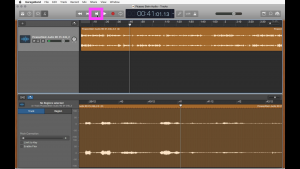
Begin by using the rewind button to return the playhead to the beginning of the audio. Then hit "play" (we recommend you use the spacebar, which both starts and stops the playhead).
Listen for your first edit.
When you find something that you want to cut out, stop and listen to that section again, and notice how that section looks in the waveform display (sound signature) so that you can select it.
Using your cursor
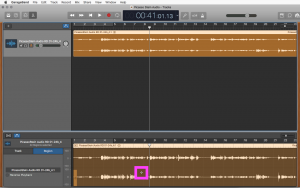
When you move the cursor into the lower half of the lower audio pane, it turns into a crosshair shape. You use the crosshairs to select the parts of the audio you want to edit by clicking and dragging in that pane.
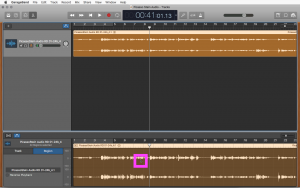
When you move cursor into the upper half of the lower audio pane, it turns into an arrow (the standard shape of your cursor). You will use the arrow to separate and move the parts of the audio you have selected.
Selecting, cutting, and moving audio
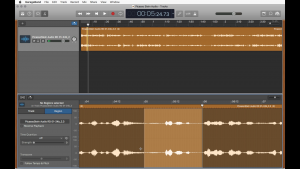
Using the crosshairs to click and drag, select the portion of the audio that you want to delete or move.
Tip: if you hit "play" (the spacebar) after you've made a selection, Garageband will play only the portion of audio that you've selected. This is an easy way to check that you have selected the right thing.
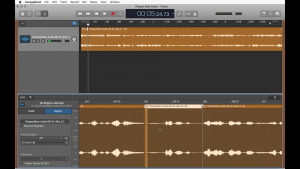
You can turn your selection into its own "region" (an independent, movable section of audio) by clicking once on the selection with the arrow cursor.
Tip: if you know you want to delete your selection, you don't have to make it a separate region first. You can simply hit "delete" on your keyboard, and that portion of the audio will disappear.
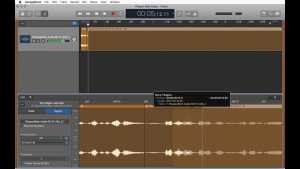
Tip: edit carefully! It's easy to cut off the beginning or end of words, so once you've made the edit, go back and check before moving on.
You can now use your arrow cursor to drag the audio you want to keep so that it is contiguous with the preceding audio. If you want, you can simply drag it over the section of audio that you want to get rid of—dragging one region over another will overwrite what's there.
You may want to zoom in (using the bottom slider) to finely align the clips.
Tip: selecting Edit→Alignment Guides turns on the "snap" function that will help you make your regions contiguous as you edit.
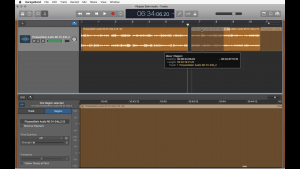
Selecting and cutting out parts of an audio region can only be done on the lower pane. But you can move regions around on either pane. The upper ("macro") audio pane is useful for moving larger regions around—for instance, if you decide to move one section of the discussion to a different place in the audio (but remember to do this sparingly).
Sometimes you may want to save a clip you have isolated, to use in another location later. To do that, choose track→new track with duplicate settings and then, on the upper pane, drag that clip into the new track and turn off the audio by clicking the mute icon (see below—it's the speaker with the line through it).
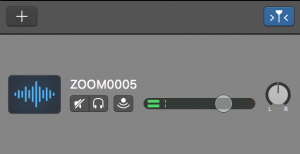
Using the undo function
If you make a mistake, you can easily undo it with command + Z (or by selecting Edit→Undo). GarageBand allows multiple undos, unless you have recently saved the file. Saving the file takes away your ability to undo the last action.
Tip: GarageBand autosaves frequently, and this does not interfere with the undo function. You may want to only save the file manually at strategic moments when you know you don't need to undo any mistakes.
Adjusting audio levels
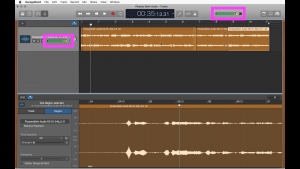
Before you export your edited audio file, you may want to boost the volume, or "level," of your audio. You can do this by moving the slider to the left of the track, and you can also adjust the universal output level at the top of the window.
Tip: as you watch the audio meters (the moving color bars outlined in pink above) a good rule of thumb is to try to have the loudest parts of the recording reach into the orange-colored areas, or, every once in a while, into the red.
Exporting your edited file
When you are done editing, select Share→Export Song to Disk. You'll be given the option to choose where and under what name to save the resulting file. Exporting creates a whole new audio file that reflects your edits. You can use this exported file in your video.
If you want to change something about your edit, you can always do so in this saved GarageBand project, and then re-export a new file.
Import Voice Track in Garage Band Audio
Source: https://smarthistory.org/editing-audio-with-garageband-cutting-and-exporting/
0 Response to "Import Voice Track in Garage Band Audio"
إرسال تعليق